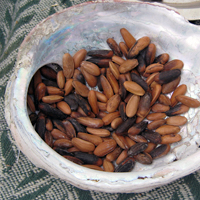Jacquelyn Ross

Jacquelyn Ross has been a volunteer with the Tending and Gathering Garden at the CacheCreek Nature Preserve for 10 years.
Could you tell us why this place, in particular, the Tending and Gathering Garden, is important to you?
The preserve is important because it is an open, rich environment just outside a sizable city. People can come and be away from industry and heavy habitation and see what the world can be like. It is important to me because it is an outdoor teaching gallery for people that want to see fiber and food plants that are essential to the native people in California. Visitors can learn a bit about how others have been continually using these plants and how they have been taking care of them.
Are you involved with any of the activities that go on in the Tending and Gathering Garden?
I've been involved in the demonstration stations for educational events. For example, when we have people who come through the Behrs Environmental Leadership Program or other international efforts, they want to see what's going on and they want to know the scientific edge of things and the intersection with traditional cultural practice. I've also demonstrated cordage- making from dogbane, and discussed the CCNP policy for plant gathering in the Garden. People are curious about how an inter-tribal group came up with policy to work within a larger non-profit. Visitors want to know how California Native Americans live today. They think we have many practices disconnected from our ancestors, and that's usually not the case. There is actually quite a continuum of skills and values that are passed from each generation to the other.
Could you speak a little bit about cultural misconceptions?
I think the largest misconception with the garden is that the products and the baskets that they see are really easy to produce. To walk somebody through the actual seasonal timeline is rewarding. One starts to get a sense of how many hours it takes, the importance of strong environmental knowledge, knowing what to pick and when, and how to recognize a healthy plant from a sick plant. It’s quite interesting talking to people and watching them calculate the distance from their own cultural roots. For some, it has been three or four generations since they've gathered or processed their own food from a natural area. So it helps people realize how far we've moved away from foods, traditional skills, and the benefits of going back to some of those roots. I think it helps people get in touch with who they are, and it helps them acknowledge and value their own cultures. It also helps them not to be so quick to accept an amalgamation that is popular but really doesn't belong to anybody.
When you talk about people being removed from those traditions were you talking about nonnative people or just everybody?
I think it could apply to anybody when they realize there is a gulf between themselves their ancestors; some things are really great, really valuable, and worth revitalization.
What are a few of the connections and how did it manifest in your own life or tradition?
I was fortunate to have been brought up in both marine and agriculture environments. Much of the food I grew up with was harvested naturally or grown. I was lucky to have a childhood nourished by the land and not having to buy too much. This gave me skills and confidence growing up, feeling like I would never be in need of food because I would always know where to find it or how to produce it.
What are your favorite experiences here?
One of our tending and gathering committee members was doing his PhD project here and on a research site on the Mokolumne River. So he set up a burn with almost ideal conditions for what a traditional cultural burn would look like. We intentionally burned plant litter on the land to encourage more vigorous growth of desirable plants. This also reduces the chance of a catastrophic fire during a high burn period. I had talked with an elder four hours north from the burn site about what might happen in the burn. Just about everything he told me that would happen did happen, from seeing the birds come after the burn to dust themselves in the ashes, to seeing certain insects fly out and the increased presence of avian life sitting on the outskirts of that burn waiting for the insects and feasting on them. I also heard about the deer that nestled in the ashes that evening, leaving the imprints of their body in the morning.
What do you see for the future of the garden?
I hope the garden will not change dramatically in the coming years. I think it’s a good size, and it’s on a scale that can be managed well within the CCNP as it is. But perhaps some day, in a different location if the board is amenable to it and if the committee is amenable to it, we might look at other plants that are aquatic in nature. I think everybody is concerned about the invasive marine plants and marine life in the area near our county and neighboring county. But right now, I think people feel good about what’s offered and having the resources to maintain that.
To download the audio, right click on the audio link above and scroll
to "Save link as . . ." and choose the directory where you want to
store the mp3. In Windows, you may have to use Control + S to select the link.